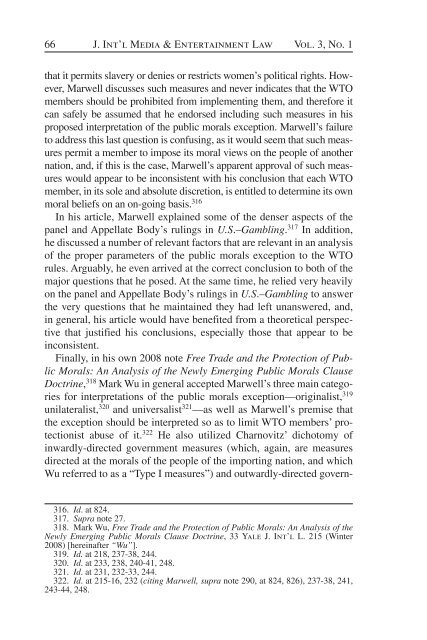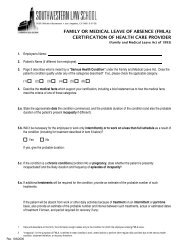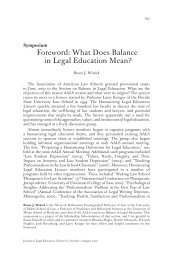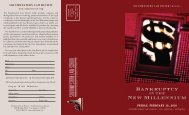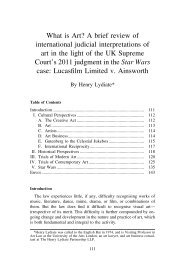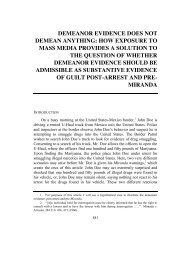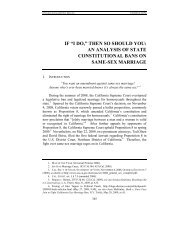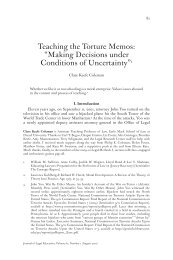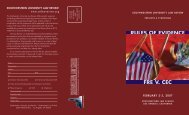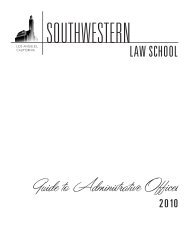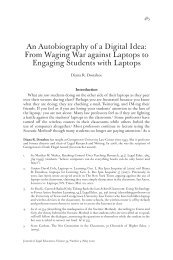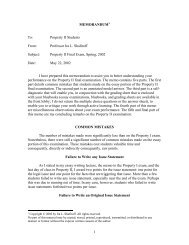Censoring the Censors in the WTO - Southwestern Law School
Censoring the Censors in the WTO - Southwestern Law School
Censoring the Censors in the WTO - Southwestern Law School
Create successful ePaper yourself
Turn your PDF publications into a flip-book with our unique Google optimized e-Paper software.
66 J. Int’l Media & Enterta<strong>in</strong>ment <strong>Law</strong> Vol. 3, No. 1<br />
that it permits slavery or denies or restricts women’s political rights. However,<br />
Marwell discusses such measures and never <strong>in</strong>dicates that <strong>the</strong> <strong>WTO</strong><br />
members should be prohibited from implement<strong>in</strong>g <strong>the</strong>m, and <strong>the</strong>refore it<br />
can safely be assumed that he endorsed <strong>in</strong>clud<strong>in</strong>g such measures <strong>in</strong> his<br />
proposed <strong>in</strong>terpretation of <strong>the</strong> public morals exception. Marwell’s failure<br />
to address this last question is confus<strong>in</strong>g, as it would seem that such measures<br />
permit a member to impose its moral views on <strong>the</strong> people of ano<strong>the</strong>r<br />
nation, and, if this is <strong>the</strong> case, Marwell’s apparent approval of such measures<br />
would appear to be <strong>in</strong>consistent with his conclusion that each <strong>WTO</strong><br />
member, <strong>in</strong> its sole and absolute discretion, is entitled to determ<strong>in</strong>e its own<br />
moral beliefs on an on-go<strong>in</strong>g basis. 316<br />
In his article, Marwell expla<strong>in</strong>ed some of <strong>the</strong> denser aspects of <strong>the</strong><br />
panel and Appellate Body’s rul<strong>in</strong>gs <strong>in</strong> U.S .– Gambl<strong>in</strong>g .<br />
317<br />
In addition,<br />
he discussed a number of relevant factors that are relevant <strong>in</strong> an analysis<br />
of <strong>the</strong> proper parameters of <strong>the</strong> public morals exception to <strong>the</strong> <strong>WTO</strong><br />
rules. Arguably, he even arrived at <strong>the</strong> correct conclusion to both of <strong>the</strong><br />
major questions that he posed. At <strong>the</strong> same time, he relied very heavily<br />
on <strong>the</strong> panel and Appellate Body’s rul<strong>in</strong>gs <strong>in</strong> U.S .– Gambl<strong>in</strong>g to answer<br />
<strong>the</strong> very questions that he ma<strong>in</strong>ta<strong>in</strong>ed <strong>the</strong>y had left unanswered, and,<br />
<strong>in</strong> general, his article would have benefited from a <strong>the</strong>oretical perspective<br />
that justified his conclusions, especially those that appear to be<br />
<strong>in</strong>consistent.<br />
F<strong>in</strong>ally, <strong>in</strong> his own 2008 note Free Trade and <strong>the</strong> Protection of Public<br />
Morals: An Analysis of <strong>the</strong> Newly Emerg<strong>in</strong>g Public Morals Clause<br />
Doctr<strong>in</strong>e , 318 Mark Wu <strong>in</strong> general accepted Marwell’s three ma<strong>in</strong> categories<br />
for <strong>in</strong>terpretations of <strong>the</strong> public morals exception—orig<strong>in</strong>alist, 319<br />
unilateralist, 320 and universalist 321 —as well as Marwell’s premise that<br />
<strong>the</strong> exception should be <strong>in</strong>terpreted so as to limit <strong>WTO</strong> members’ protectionist<br />
abuse of it. 322 He also utilized Charnovitz’ dichotomy of<br />
<strong>in</strong>wardly-directed government measures (which, aga<strong>in</strong>, are measures<br />
directed at <strong>the</strong> morals of <strong>the</strong> people of <strong>the</strong> import<strong>in</strong>g nation, and which<br />
Wu referred to as a “Type I measures”) and outwardly-directed govern-<br />
316. Id. at 824.<br />
317. Supra note 27.<br />
318. Mark Wu, Free Trade and <strong>the</strong> Protection of Public Morals: An Analysis of <strong>the</strong><br />
Newly Emerg<strong>in</strong>g Public Morals Clause Doctr<strong>in</strong>e, 33 Yale J. Int’l L. 215 (W<strong>in</strong>ter<br />
2008) [here<strong>in</strong>after “Wu”].<br />
319. Id. at 218, 237-38, 244.<br />
320. Id. at 233, 238, 240-41, 248.<br />
321. Id. at 231, 232-33, 244.<br />
322. Id. at 215-16, 232 (cit<strong>in</strong>g Marwell, supra note 290, at 824, 826), 237-38, 241,<br />
243-44, 248.<br />
3058-088-3pass-02_Wright-r03.<strong>in</strong>dd 66<br />
6/30/2010 12:02:01 PM


